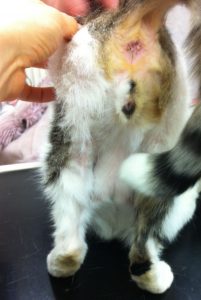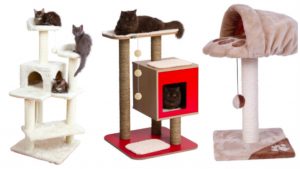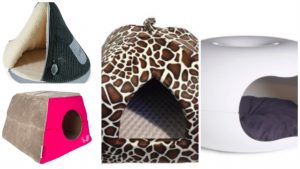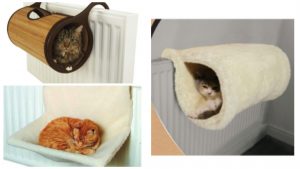Is Your Home Feline Friendly?!
Cats are the most popular pets in the UK and one of the main reasons for their popularity is that they are seen as ‘low maintenance’ animals who fit in well with our modern, busy lifestyles.
This is true but it is important that we also fit in with theirs! Cats take a very different view of the world to humans but are very bad at showing us that they are stress or unhappy.
It is important, therefore, that we as pet owners ensure our houses are as ‘feline friendly’ as possible.
Signs of stress
High levels of stress in cats can lead to both behavioural (mental) problems and also physical illness.
One of the most common behavioural symptoms of stress in cats is ‘over-grooming’. Cats will use grooming as a displacement activity and stress reliever but if they are chronically (long term) stressed they will groom themselves bald.

This cat has over-groomed the fur on her backlogs and also her tummy, a classic sign of stress.
Another change which indicates they are unhappy is them urinating or defecating in the ‘wrong’ place. As in not their litter trays (if they have one) but maybe in concealed space (behind the TV or sofa is a favourite) or by windows or doors – lovely! If this starts to happen to your cat, don’t punish them but think carefully about why it might be happening. For example, maybe you don’t have enough trays, the ones you do have are in an exposed spot, or a cat outside is stressing them out and they are territory making.
The most frequently diagnosed health problem due to stress is recurrent cystitis, although it is important to rule out physical illness first.
However, remember that not all stressed cats will show obvious symptoms, the majority will simply become withdrawn, grumpy and distant. Some may not show any signs at all, which is why it is so important that we are vigilant and put the measures below in place, even if we don’t think there is a problem.
Multi cat households
Many households have more than one cat, some will be litter mates, (the best combination for happy co-habitation) but others have been brought together as ‘companions’ by their owners. What is important to realise is that cats are naturally solitary creatures and living with strangers can be a significant cause of tension. They simply do not have the same need for companionship as humans.
They also hate to share! For a stress free life a cat needs unfettered access to; food, water, a toilet and a rest area. If they go outside, they also need predictable, unimpeded access.
Therefore it is vital in multi-cat households that we provide our pets with enough resources so there is no competition and therefore no stress.
Food and water
In practice, this means providing one more food bowl than there are cats, and they should be well spread out. Two food bowls on the same mat, is just one food bowl to a cat!
The best way to feed cats is with dry food left down all day. Not only are they naturally grazing feeders but offering a set meal once or twice daily forces the cats to come together and make them feel under pressure to eat. This can lead to competition for food and, as they tend to gorge at these times, over eating and obesity. We may enjoy sharing a meal with friends but cat’s definitely do NOT!
Also, cats dislike drinking water next to their food source. This stems from their hunting nature where any water supply near to the prey was likely contaminated. They also prefer a wide bowl filled to the brim as they don’t like to catch their whiskers on the sides. Both these reasons are why cats will often drink from the dogs bowl or outside and completely ignore the lovely bowl of fresh water you have left for them!
Rest areas
Always make sure you have enough rest areas in your home for your cats, and they are suited to the preferences and needs. Cats like to be up high, they are after all natural climbers. Raised beds make them feel more secure and allow them to survey their territory. Cat trees and scratching posts are excellent for this but ensure you provide at least one for each cat, so there isn’t competition for the highest position.

Cat trees that come with raised beds can be great for nervous cats to rest in, but make sure there are enough spots to go around!
Also, if you find your cats clustered in one spot, next to a radiator for example, it could be because they all love each other but it is more likely that that is the only available warm or comfy area!
If you have a cat who likes to hide away, ensure they have the facilities to do that, a covered bed is perfect. Remember, to a cat, they are ‘hidden’ if they can’t see you, it doesn’t matter if you can see them!

Covered beds come in all shapes and sizes and are excellent for cats! Create a double whammy of comfort and security by placing them up high somewhere!
Litter Trays
Don’t forget the litter trays! Cats hate a dirty tray and will often defecate or urinate elsewhere rather than use one. If you do have trays in the house, always ensure that there is at least one per cat, that they are spread out and in a quiet area.
I am sure you wouldn’t like to poo in front of a window or french doors and neither does your cat! If you don’t have a private area for them to go in, covered litter trays are an excellent compromise.
Interacting with your cat
Cats are known as ‘high intensity, low frequency’ interactors. This means they prefer to rub past your legs several times a day and accept a quick stroke, rather than spending a whole evening being fussed.
Humans, on the other hand, are ‘low frequency, high intensity’ interactors and this can often cause cats unnecessary stress as we would prefer to sit and cuddle for ages while we watch TV in the evening.
As cats are generally solitary, they will not seek out our company like dogs, although they are happy to sit on you when they please! They are at their most secure when they can chose the level of interaction, this is why some cats hate to be picked up but will happily sit on or near you when you are watching TV or on the computer.
It is important to remember that cats find unrequested interaction stressful, which is why one the worst things you can do to a timid cat is take them from their hiding place and ‘force’ them to be sociable.
Pheromones
The use of Feliway diffusers and sprays can really help a cat to feel secure and relaxed in their environments. These contain a pheromone scent derived from the one which cats spread when they rub against things. Plug the diffuser in as near as possible to where your cat spends the majority of his time and don’t forget to check it regularly and replace it when it runs out.
If you are concerned that your cats may be stressed, have a chat with your local vets. They should be able to give you advice specific to your situation and make sure your house is as ´Feline Friendly´ as possible!
You can follow me on Twitter; @cat_the_vet and find me on FaceBook; Cat_The_Vet
